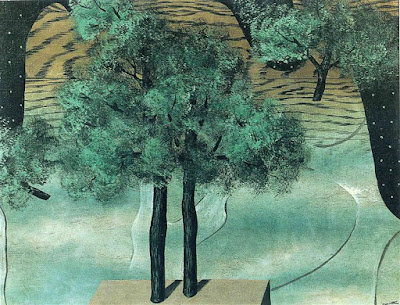 |
| The Cultivation of Ideas by Rene Magritte* |
Let me begin by saying that the core content and concepts of Yoga for Healthy Aging remain unchanged and are holding up beautifully since we started in the summer of 2015. But as I was reflecting on my perspective on the four physical skills of strength, flexibility, balance, and agility, it becomes more and more clear to me that maintaining strength is the foundational focus out of which the other three skills grow. Without at least adequate strength, it is hard to find balance and agility or take advantage of whatever flexibility you may already possess. Strength is already the first of the four physical skills we cover in the course, and I now make a point now of emphasizing this essential point right up front. I often suggest that if you are not sure where to start in your home practice in investigating the four skills, start with strength and you can’t go wrong. And I have also been intentionally discussing hyperflexibility, including cautions and approaches to working with it, during our talk on flexibility, because this affects many yoga practitioners and has been often overlooked in the past in mainstream yoga (see Are You Overly Flexibile? Hyperflexibility, Joint Hypermobility Syndrome and Generalized Joint Hypermobility).
Of course, as new information and concepts have come to light that support our ideas or advance our understanding of yoga and aging—especially from the writings of our talented blog contributors—I incorporate some of those findings into the course. For example, I now take some time to discuss the titin molecule in our muscles and how longer holds may improve flexibility in part due to changes in this structure in muscles (see Friday Q&A: How Long to Stretch). I also weave in newer information about brain health from the rich writings of Ram Rao, such as his 2017 post on meditation and the brain Meditation Techniques and Brain Structure) and his post on a new study on yoga and balance New Studies on Aging, Balance, and Yoga. And I will update our presentation on the flight-or-fight response based on Nina’s recent piece Why are we so stressed out? to reflect the most up-to-date understanding of this basic human reaction to stress.
Because I’ve realized the limits of always doing poses the same way (you get really good at that body position, but not the vast array of other possible places to challenge yourself), and the benefits to the brain of continued new learning, I now place more emphasis on learning to vary your poses by changing them on your own. This allows you to creatively explore new body positions in your basic poses, challenging your strength, flexibility, balance, and agility in new ways, while stimulating your brain with new learning. For example, you could vary Warrior 2 pose by doing different arm variations, either to improve overall strength in your upper body or to improve brain health by engage your mind practicing new positions. (see the video Dynamic Warrior 2 with Crazy Arms as an example ). You can also use this creative approach to come up with new variations that help you to accommodate to your particular physical limitations and changing health status that are an inevitable part of life.
These are just some of the ways my thoughts on teaching yoga for healthy aging have evolved so far, and as I continue learn new things myself I will continue to update the course to reflect my latest ideas. Who knows what I’ll learn between now and July! If you have not yet signed up for the July intensive in July 23rd-28th, 2018 at the Namaste Yoga Studio in Berkeley, CA, Early Bird pricing is good through June 1st. And for everyone in the San Francisco East Bay Area, Nina and I will have a book signing—open to the general public—during the intensive on Thursday, July 26th from 4:30-5:30pm. Click here to learn more about the intensive and get registered.
Subscribe to Yoga for Healthy Aging by Email ° Follow Yoga for Healthy Aging on Facebook and Twitter ° To order Yoga for Healthy Aging: A Guide to Lifelong Well-Being, go to Amazon, Shambhala, Indie Bound or your local bookstore.
Follow Baxter Bell, MD on YouTube, Facebook, and Instagram. For upcoming workshops and retreats see Baxter's Workshops and for info on Baxter see baxterbell.com.
No comments:
Post a Comment